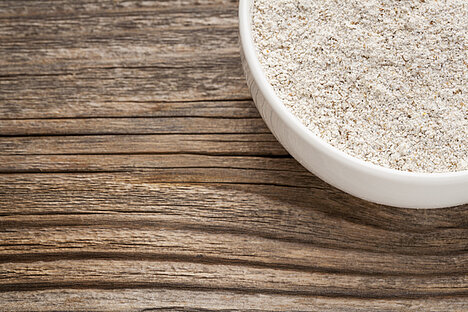Rice flour

But what does pregelatinized rice flour have to do with dogs? Can it be used as a feed additive or as a dietary supplement for dogs? What advantages and disadvantages does it have for the health and well-being of dogs? In this article, you'll find out more about rice flour for dogs and how to use it correctly.
Rice flour as a feed additive for dogs
Rice husk flour can be used as a feed supplement for dogs to aid digestion. It has a high soluble fiber content, which can stimulate intestinal activity and improve stool consistency. Rice flour can also help to stop diarrhea by binding excess water in the intestines and thus reducing fluid loss.
Rice flour can also be helpful for dogs with food allergies or intolerances, as it is gluten-free and contains no allergenic substances. It can therefore be used as a substitute for cereal flours in homemade dog food recipes.
Rice bran flour also has a low fat content and a moderate energy content, making it a suitable food supplement for overweight or older dogs who need fewer calories.
Rice flour as a dietary supplement for dogs
Rice bran meal can also be used as a dietary supplement for dogs to compensate for inadequate digestion. There are special diets that contain rice bran, such as Alga Humin. This product combines rice flour with humic acids and algae meal (Spirulina platensis) to stabilize the intestinal flora, promote nutrient absorption and strengthen the immune system.
Alga Humin can be used for dogs with chronic or acute digestive problems such as flatulence, constipation, diarrhea or vomiting. It can also help with the simultaneous intake of medication that can impair intestinal function.
The recommended dosage of Alga Humin depends on the dog's body weight and is between 5 g and 50 g per day. It should be taken at least two hours apart from other remedies.
Advantages and disadvantages of rice bran meal for dogs
Rice flour has several benefits for dogs that should not be underestimated:
- It is gluten-free and hypoallergenic
- It aids digestion and can stop diarrhea
- It keeps the food fresh and tasty
- It has a low fat content and a moderate energy content
- It can be combined with other natural substances to promote health
However, rice bran meal also has some disadvantages that need to be considered:
- It is not a complete feed and should only be used as a supplement
- It can lead to constipation or flatulence if the dosage is too high
- It can affect the absorption of other nutrients or medication
- It may be unsuitable for dogs with kidney problems or diabetes as it contains high levels of phosphorus and carbohydrates.
Rice flour is a versatile and natural flour that can provide a number of benefits for dogs. It can be used as a food additive or dietary supplement to aid digestion, prevent allergies or improve well-being. However, it should always be used in moderation and according to instructions to avoid possible disadvantages. Rice flour is not a substitute for a balanced and species-appropriate diet for dogs.
If you notice any signs of hypersensitivity or poisoning in your dog, you should see your vet immediately. We are not a substitute for a vet, but we try to be as accurate as possible. Every dog reacts differently and we recommend you get a second opinion or consult your vet if in doubt.
Stay healthy and take good care of your four-legged friend!😊